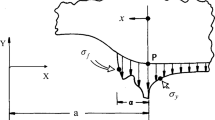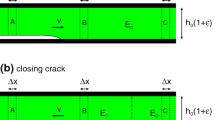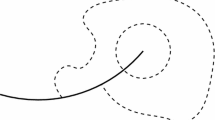Abstract
A mapping technique is used to derive an integral expression for the energy release rate for a quasistatically propagating crack. The derivation does not depend on any assumptions in regard to the contitutive behavior of the material. It leads to a contour integral around the crack tip, plus an area integral over the region enclosed by this contour. Only the stress and displacement fields appear in the integrands. Although for stationary crack solutions known to the authors the area integral is not convergent, for propagating crack solutions in elastoplastic material, the integrals are convergent, and lead to zero energy release rate. This confirms conclusions by Rice from an independent point of view.
Similar content being viewed by others
References
A.A. Griffith, Transactions, Royal Society of London, Series A 221 (1920) 163–198.
A.A. Griffith, Proceedings, First International Congress of Applied Mechanics, Delft (1924).
G.R. Irwin, Fracturing of Metals, American Society for Metals, Cleveland (1948).
E. Orowan, Report of Progress in Physics 12 (1949).
G.R. Irwin, in Sagamore Conference Proceedings, Vol. II, Syracuse University Press (1956) 289–305.
G.R. Irwin, Journal of Applied Mechanics 24 (1957) 361–364.
M.L. Williams, Journal of Applied Mechanics 24 (1957) 109–114.
J.R. Rice, Journal of Applied Mechanics 35 (1968) 279–386.
J.W. Hutchinson, Journal of the Mechanics and Physics of Solids 16 (1968) 13–31.
J.R. Rice an G.F. Rosengren, Journal of the Mechanics and Physics of Solids 16 (1968) 1–12.
S. Aoki, K. Kishimoto and M. Sakata, Journal of Applied Mechanics 48 (1981) 825–829.
L.B. Freund and J.W. Hutchinson, Journal of the Mechanics and Physics of Solids 33 (1985) 169–191.
B. Moran and C.F. Shih, Engineering Fracture Mechancs 27 (1987) 615–642.
J.C. Amazigo and J.W. Hutchinson, Journal of the Mechanics and Physics of Solids 25 (1977) 81–97.
Y.C. Gao and K-C. Hwang, in Proceedings, 5th International Congress of Fracture 2 (1981) 669–682.
J.R. Rice, Mechanics of Solids, H.G. Hopkins et al. (eds.), (1982) 539–562.
J.R. Rice, in Proceedings, 1st International Congress of Fracture 1 (1966) 309–340.
J.R. Rice, in Proceedings, 8th U.S. National Congress of Applied Mechanics, R.E. Kelly ( ed.), Western Periodicals, North Hollywood, California (1979) 191–216.
J. Kestin, A Course in Thermodynamics, Vol. II, Hemisphere Publishing (1979).
Q.S. Nguyen, in Advances in Fracture Research, D. Francois et al. (eds.), (1981) 2179–2185.
Q.S. Nguyen, in Three-Dimensional Constitutive Relations and Ductile Fracture, S. Nemat Nasser (ed.), (1981) 315–330.
Author information
Authors and Affiliations
Rights and permissions
About this article
Cite this article
Peek, R., Deng, X. A new look at energy release rates for quasistatically propagating cracks in inelastic materials. Int J Fract 59, 151–160 (1993). https://doi.org/10.1007/BF00012388
Received:
Accepted:
Issue Date:
DOI: https://doi.org/10.1007/BF00012388




